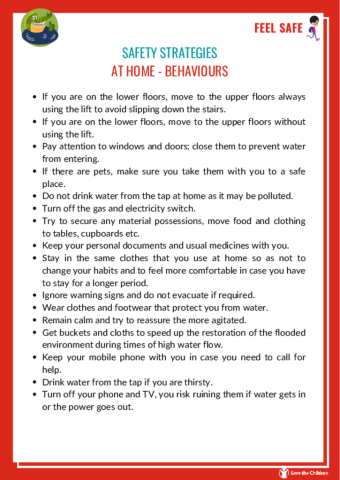Safety Strategies
Objectives:
- Understand the correct behaviors to adopt in emergency situations related to flooding.
- Develop analytical skills and the ability to justify decisions.
- Promote teamwork and communication among participants.
STEP BY STEP
Before starting
Floods can occur rapidly and have devastating consequences. Knowing how to manage an emergency situation is essential for ensuring your safety A condition that makes one feel that one is not in danger or that a risk can be prevented or reduced and that of others. Understanding the appropriate behaviors to adopt during a flood can not only save lives but also minimize damage to property and facilitate recovery phase in the risk management cycle that involves the removal of all possible obstacles to facilitate the resumption of normal living conditions after the event.
The teacher introduces the importance of preparation in the event of a flood, explaining the potential consequences of inadequate responses. They emphasize that being informed and ready can significantly impact the outcome during such emergencies.
Behaviour Game
The class is divided into three groups, each assigned to a specific scenario:
At Home - On the Street - After the Flood
The teacher provides each group with a list of behaviors relevant to their scenario (see attached "Safety Strategies - Behaviors" below).
The teacher explains that each group will have 30 minutes to discuss and analyze the behaviors. The following instructions are to be followed:
-
Identification of Behaviours: Each group should read the list carefully, circling the behaviors they consider appropriate and underlining those they believe are inadequate.
-
Justification of Choices: For each selected behavior, the group must provide at least two reasons. For example, if they choose "do not drink tap water," they could explain the risk of contamination and the importance of health safety.
-
In-Depth Reflection: Each group should also discuss how their chosen behaviors impact not only themselves but also the safety of the community or those nearby. For instance, they can explore how their choices might prevent further emergencies or help maintain calm among people.
To facilitate the discussion, the teacher can write the following guiding questions on the board:
- What is the immediate risk of this behavior?
- How might this behaviour influence others around us?
- Are there better alternatives to this behaviour?
Concluding thoughts
At the end of the allotted time, each group must prepare a summary of their choices and justifications to present to the rest of the class. The teacher reminds them to be ready to explain not just the "what" but also the "why" behind their decisions.
Finally, the teacher facilitates a plenary discussion, highlighting the most effective behaviours and the lessons learned for ensuring safety in the event of a flood. This collective sharing allows students to reflect on their insights and reinforces the importance of being prepared and informed.

Add new comment